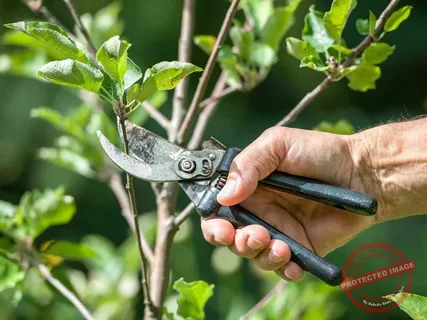If you’ve ever walked across a lush, green lawn and thought, I wish mine looked like that, you’re not alone. Every homeowner dreams of having that soft, rich carpet of grass underfoot — the kind that stays green even when the weather turns cool. But here’s the secret: the best time to make that happen isn’t spring. It’s fall.
Yep, fall. While most folks are packing away their garden tools and rakes, those in the know — the ones with the greenest lawns on the block — are busy seeding. The cooler air, warm soil, and steady moisture of fall create the perfect environment for grass seed to take root and thrive. It’s nature’s way of saying, “Alright, let’s grow something good before winter hits.”
I’ve been tending lawns and pastures for years, and I’ll tell you this: seeding a lawn in fall is one of those tasks that pays off big. It’s not just about throwing seeds around and hoping for the best. It’s about understanding your soil, timing things right, and giving those little grass seeds the best possible start in life. So, grab a cup of coffee and let’s dig in together. Here’s everything you need to know about how to seed a lawn successfully in fall — the full, no-nonsense guide from someone who’s been there, done that, and got dirt under the nails to prove it.
Why Fall is the Best Time to Seed a Lawn
You might be wondering — why fall? Why not spring when everything’s blooming and green? Well, think of fall as the season when your lawn can grow in peace. In spring, weeds like crabgrass and clover are waiting to compete. But in fall, most weeds are dying off. That means your new grass seed gets all the space and nutrients it needs to grow strong roots before winter.
The soil is still warm from summer, and the air is cool — perfect for root development. Grass grows faster and stronger without the stress of scorching sun. It’s like sending your lawn to a peaceful retreat before the busy growing season ahead.
If you’ve ever tried greenlawn lawn care tips before, you probably know timing is everything. And fall gives you a window of opportunity most folks overlook.
Step 1: Test and Prepare Your Soil
You can’t grow good grass in tired soil. That’s rule number one. The first thing I always do before seeding is grab a soil test kit — you can find one at any garden center or hardware store. It’ll tell you whether your soil is too acidic or lacking nutrients. Most lawns do best with a pH between 6.0 and 7.0.
If your soil’s too acidic, sprinkle in some pelletized lime. If it’s too alkaline, use sulfur to bring it down. Think of this like setting the table before the meal — you want your soil ready to feed those seeds properly.
Once that’s done, mow your existing grass low and rake away the clippings, sticks, and leaves. Then lightly loosen the top inch or two of soil with a garden rake. That gives your seed somewhere soft to land and dig in. You can even use a dethatcher or aerator to help air, water, and nutrients reach deeper down.
Step 2: Choose the Right Grass Seed
Here’s where a lot of folks go wrong — they grab whatever seed is on sale and toss it down. But not all grass is created equal. You’ve got to match your seed to your region and your lawn’s sunlight.
If you live up north, cool-season grasses like Kentucky Bluegrass, Tall Fescue, or Perennial Ryegrass do great. Down south? Look at Bermudagrass, Zoysia, or Centipedegrass.
Personally, I’ve had amazing results with Pennington Smart Seed Sun & Shade Mix — it fills in bare patches quickly and holds up through the seasons. You can find it online or at Tractor Supply, Home Depot, or any greenlawn lawn care supplier.
When choosing seed, also think about how you use your lawn. Got kids or pets that run around a lot? Go for a durable mix like Tall Fescue. Want that golf-course look? Try Kentucky Bluegrass for a finer texture.
Step 3: Time It Right
Timing is crucial. Fall seeding usually works best between mid-August and mid-October, depending on your region. The goal is to get seeds established before the first hard frost.
Here’s a simple trick I use: if you can still comfortably wear a light jacket outside during the day, your soil is probably warm enough to seed. Once those nightly temperatures dip below 50°F consistently, it’s usually too late.
If you’re unsure, your local greenlawn lawn care service or agricultural extension office can help pinpoint your area’s seeding window.
Step 4: Spread the Seed Evenly
Now comes the fun part — spreading the seed. You can do it by hand for small patches or use a broadcast spreader for larger lawns. The key is to spread it evenly, not too thick or too thin.
I like to make two passes with the spreader — one north to south, the other east to west. This ensures even coverage and avoids patchy areas. Don’t bury the seed too deep; grass seeds need sunlight to sprout. A light rake over the top will do just fine.
If you’re overseeding an existing lawn, you can skip tilling altogether. Just rake lightly to expose the soil and spread your new seed over it.
Step 5: Add a Starter Fertilizer
Here’s a secret I learned after years of trial and error: starter fertilizer makes all the difference. It gives your seeds a boost of phosphorus and potassium for strong roots and faster germination.
Look for a fertilizer labeled “Starter Lawn Food” or one with an NPK ratio like 10-10-10 or 12-12-12. I recommend Scotts Turf Builder Starter Food for New Grass — it’s easy to apply and gentle on young seedlings.
Apply the fertilizer right after seeding, using the same spreader. Then water gently so it seeps into the soil. Think of it as a baby’s first meal — full of the nutrients they need to grow strong and healthy.
Step 6: Water Wisely
Grass seed loves moisture, but too much water can drown it. The trick is to keep the top inch of soil consistently damp — not soaked.
For the first two weeks, water lightly two or three times a day if there’s no rain. Once you see those first green shoots, you can reduce watering to once a day. After three or four weeks, give your lawn deeper soaks just a few times per week.
A sprinkler with a fine mist setting works best. My go-to is the Melnor XT Turbo Oscillating Sprinkler — it covers evenly without washing seeds away.
Here’s a small tip from my own mistake: I once forgot to water for three days during a dry spell. Half the seed sprouted; half didn’t. Now I set a reminder on my phone — it’s worth it.
Step 7: Protect and Nurture
Birds love grass seed almost as much as we love green lawns. To protect your new seed, you can lightly cover it with straw or use a biodegradable seed blanket. This helps retain moisture too.
If you’re using straw, make sure it’s clean (weed-free) and spread thin enough for sunlight to still reach the soil. Once the grass starts sprouting, you can rake off any leftover straw.
Step 8: Mow Carefully
The first mowing is a big moment. Wait until your new grass is about 3 to 4 inches tall before you mow. Make sure your mower blades are sharp — dull blades can tear young grass and stunt its growth.
Set your mower high, around 3 inches, and don’t remove more than one-third of the blade at a time. This helps the roots establish and keeps your grass looking thick and even.
Step 9: Feed Again Before Winter
About four to six weeks after seeding, give your new lawn one more feeding with a slow-release fertilizer. This helps your grass store nutrients for winter dormancy and gives it a head start in spring.
Milorganite Organic Nitrogen Fertilizer or Jonathan Green Winter Survival Lawn Food are great options. They provide long-lasting nutrition without burning your young grass.
A Short Story from the Farm
Last fall, my neighbor Clara decided to reseed her front yard. She had given up after trying every quick-fix fertilizer on the shelf. I helped her test the soil, pick the right seed, and follow this fall seeding process.
By November, her yard looked like something out of a postcard — soft, green, and full. She said, “I never thought I’d see my kids playing barefoot on the grass again.”
That’s when it hit me — it’s not just about having a pretty lawn. It’s about creating a space that feels alive, a patch of earth you can be proud of. Greenlawn lawn care isn’t just science; it’s heart.
FAQs: How To Seed a Lawn Successfully in Fall
Q1: Can I seed my lawn after the first frost?
It’s risky. Once the ground starts freezing at night, seeds won’t germinate properly. Aim to seed at least 6 weeks before your average first frost date.
Q2: Should I use topsoil before seeding?
If your soil is poor or uneven, a thin layer of topsoil (about 1 inch) can help improve seed-to-soil contact. Just make sure it’s not too thick.
Q3: How long does it take for grass seed to germinate?
Most cool-season grass seeds sprout within 7–14 days. Some, like Kentucky Bluegrass, can take up to 21 days, so be patient and keep watering.
Q4: Do I need to aerate before seeding?
Yes, especially if your soil is compacted. Aeration allows water and nutrients to reach deeper roots. It’s a key part of greenlawn lawn care.
Q5: Can I walk on the lawn after seeding?
Avoid heavy foot traffic until your grass reaches about 3 inches tall. If you must cross it, use planks or boards to distribute your weight.
Bonus: A Simple “Greenlawn Lawn Care” Checklist for Fall Seeding
Test your soil and fix pH levels.
Choose the right seed for your region.
Seed evenly using a spreader.
Add starter fertilizer right after.
Water lightly and often at first.
Protect seeds from birds and erosion.
Mow high once the grass reaches 3 inches.
Feed again before winter.
Keep traffic light until roots strengthen.
Sit back, sip your coffee, and admire that fresh green.
Common Mistakes to Avoid
Skipping soil prep: Your seed needs good contact with the soil to sprout. Don’t skip the raking or aerating.
Overwatering: Too much water suffocates the seed. Keep it damp, not soaked.
Seeding too late: Late seeding means roots can’t develop before frost. Always plan early.
Neglecting fertilizer: Grass seed needs that first nutrient boost to grow strong.
Ignoring weeds: Control weeds before seeding, not after.
How-To: Reseeding vs. Starting Fresh
If your lawn is mostly fine but has bare spots, you’re reseeding (or overseeding). Just loosen the soil in those areas, toss down your seed, and keep watering.
If your lawn’s a lost cause — patchy, weedy, or full of moss — it might be time to start fresh. Till the area, rake smooth, and seed like it’s brand new. Either way, fall gives your grass a strong head start before spring’s chaos.
Final Thoughts from a Fellow Grower
There’s something deeply satisfying about watching new grass take root. Maybe it’s the patience it teaches, or maybe it’s just seeing life grow from what looked like bare dirt a few weeks before.
If you take your time, prepare the soil, and give those seeds the care they deserve, you’ll have a lawn that stays thick and green through every season. That’s the beauty of greenlawn lawn care — it’s simple, steady, and it rewards those who show up.
So next time you’re out there with a rake in one hand and a seed bag in the other, remember: this isn’t just yard work. It’s growing a living, breathing patch of pride right outside your door.
What’s stopping you from getting started on your dream green lawn this fall? 🌱



